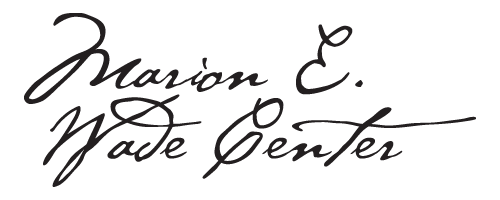Fair use is a legal principle that defines the limitations on the exclusive rights of copyright holders. (See 17 U.S. Code § 107 and the Copyright act of 1976) When the Wade Center has further information about the rights associated with an image, it will convey that information to requesters. However, in all cases, it is the requester’s obligation to determine and satisfy copyright or other use restrictions when publishing or otherwise distributing materials from the Wade Center’s collections.
Fair use guidelines apply to the use, without permission, of portions of lawfully acquired copyrighted works in educational printed or multimedia projects which are created by educators or students as part of a systematic learning activity by non-profit educational institutions. These are projects that incorporate students’ or educators’ original material, such as course notes or commentary, together with various copyrighted media formats such as motion media, text material, illustrations, and photographs.
Such uses may include:
- Class assignments
- Curriculum materials
- Remote instruction (via secure / limited distribution)
- Examinations
- Student portfolios
- Professional symposia / conferences
All uses should include proper attribution and citation. Uses of educational multimedia projects created under these guidelines are subject to the following limitations:
- Time Limitations: may be used for a period up to two years after the first instructional use with a class. Use beyond that time period, even for educational purposes, requires permission for each copyrighted portion incorporated in the production.
- Portion Limitations: means the amount of a copyrighted work that can reasonably be used in projects. In regards to illustrations and photographs, the guidelines suggest that no more than 5 images by an artist or photographer may be reproduced or otherwise incorporated as part of an educational multimedia project. When using photographs and illustrations from a published collective work, not more than 10% or 15 images, whichever is less, may be reproduced or otherwise incorporated.
- Copying and Distribution Limitations: only two use copies, including the original, may be made of an educator’s educational multimedia project. In the case of a jointly created educational multimedia project, each principal creator may retain one copy.
Examples of when permission is required:
- Using multimedia projects for non-educational or commercial purposes.
- Duplication of multimedia projects beyond limitations listed above.
- Distribution of multimedia projects beyond educational settings (for example, posting on the internet).
In light of the acknowledgement that the fair use exemption is applicable in educational instances, the Wade Center will recommend the following:
- If 5 or fewer images owned by the Wade Center are obtained by educators from a published source, the Wade Center does not need to give permission. Images should include the citation as it appears in the publication (either contiguous to the photo, or in the photo acknowledgement section), and the words “Image from the collections of the Marion E. Wade Center, Wheaton College, Wheaton, IL.” The published source should also be cited.
- However, if the educator is seeking more than 5 images, or if they are requesting that the Wade Center provides the image/scan (regardless of the quantity), a reproduction fee will apply.
- In all cases, a photo loan agreement must be signed and related fees received before any content owned by the Wade Center is posted on the internet.
- When in doubt it is recommended to contact the Wade Center and/or copyright holder.
For more on Fair Use and Copyright:
The documentation on this page was based on guidelines developed by CONFU (Conference on Fair Use, 1997)

